The Caviar-Like Peptide Complexes Market is expected to record a valuation of USD 1,102.3 million in 2025 and USD 3,725.2 million in 2035, with an increase of USD 2,622.9 million, which equals a growth of 238% over the decade. The overall expansion represents a CAGR of 12.9% and a 3.4X increase in market size.
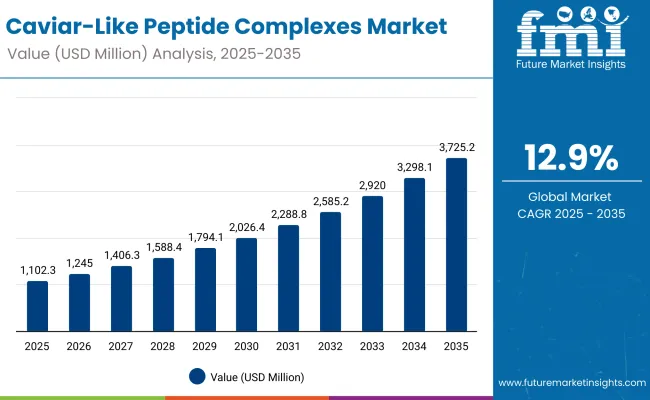
Caviar-Like Peptide Complexes Market Key Takeaways
| Metric | Value |
|---|---|
| Caviar-Like Peptide Complexes Market Estimated Value in (2025E) | USD 1,102.3 million |
| Caviar-Like Peptide Complexes Market Forecast Value in (2035F) | USD 3,725.2 million |
| Forecast CAGR (2025 to 2035) | 12.9% |
During the first five-year period from 2025 to 2030, the market increases from USD 1,102.3 million to USD 2,026.4 million, adding USD 924.1 million, which accounts for 35.2% of the total decade growth. This phase records steady adoption in anti-aging and firming applications, clinical-grade skincare, and peptide-rich serums, driven by the need for high-efficacy topical solutions. Anti-aging & firming dominates this period, representing 60.6% of the market in 2025, supported by signal peptides and carrier peptide systems that enhance skin regeneration.
The second half from 2030 to 2035 contributes USD 1,698.8 million, equal to 64.8% of total growth, as the market jumps from USD 2,026.4 million to USD 3,725.2 million. This acceleration is powered by the widespread deployment of encapsulated "caviar bead" systems, increased demand for clinical-grade claims, and the growth of serum-based delivery formats. Serums lead the product category with a 50.5% share in 2025, and clinical-grade formulations account for 51.5% of the market, further enhanced by dermatology-endorsed and high-performance skincare channels.
From 2020 to 2024, the Caviar-Like Peptide Complexes Market laid the groundwork for innovation in anti-aging skincare through early research, clinical validations, and the use of signal and carrier peptides in premium cosmetic products. By 2025, the market reached a valuation of USD 1,102.3 million, reflecting strong consumer demand for clinical-grade, dermatologist-endorsed solutions. During this period, prestige skincare brands such as La Prairie and Estée Lauder led the competitive landscape, with La Prairie capturing 9.1% of global value. Differentiation was driven by bioavailability, encapsulated caviar-bead delivery systems, and visible efficacy in wrinkle reduction and firming.
Demand for Caviar-Like Peptide Complexes is projected to grow to USD 3,725.2 million by 2035, led by anti-aging & firming claims (60.6% share in 2025), serum-based formats (50.5%), and clinical-grade positioning (51.5%). The revenue mix is shifting as brands adopt encapsulated peptide systems, invest in AI-driven personalization, and expand through dermatology clinics, e-commerce, and premium beauty retail. Traditional leaders now face growing competition from tech-integrated skincare brands offering personalized regimens and cloud-connected routines, marking a shift from formulation-led competition to ecosystem-based strategies.
Caviar-like peptide complexes are increasingly crossing over from luxury retail into clinical skincare and dermatology settings, where product efficacy must align with professional-grade standards. The integration of these complexes into post-treatment protocols such as micro needling, laser resurfacing, and injectables has elevated their credibility and demand. This crossover blurs the line between cosmetic and therapeutic skincare, positioning caviar-like peptides as a go-to ingredient for visible skin recovery and regeneration.
Brands are leveraging caviar-like peptides not just for anti-aging, but as part of multi-functional claim stacks combining firming, barrier repair, hydration, and wrinkle correction into single SKUs. This aligns with consumer preferences in markets like East Asia and Europe, where skincare minimalism meets high efficacy expectations. Peptide complexes enable this formulation economy, allowing brands to offer multitasking products that simplify routines while maintaining performance, leading to broader adoption across use cases and age groups.
The market is segmented by function, peptide system, product type, claim, distribution channel, and region. Functions include anti-aging & firming, wrinkle reduction, barrier strengthening, and hydration, representing the primary skincare benefits driving peptide complex adoption. Peptide system segmentation includes signal peptides, carrier peptides, enzyme-inhibiting peptides, and encapsulated “caviar bead” systems, each offering unique cellular repair and collagen-boosting benefits.
Based on product type, the market covers serums, creams, ampoules, and eye creams, catering to consumer needs for targeted and layered skincare routines. In terms of claim positioning, categories include clinical-grade, clean-label, vegan, and fragrance-free, reflecting growing consumer demand for high-efficacy and conscious formulations. Distribution channels span premium beauty retail, e-commerce, pharmacies, and dermatology clinics, each playing a role in expanding reach across both mass-affluent and professional skincare users. Regionally, the market scope includes North America (USA), Europe (Germany, UK), Asia-Pacific (China, India, Japan), and other emerging markets, with Asia-Pacific countries leading in CAGR due to growing demand for high-performance skincare.
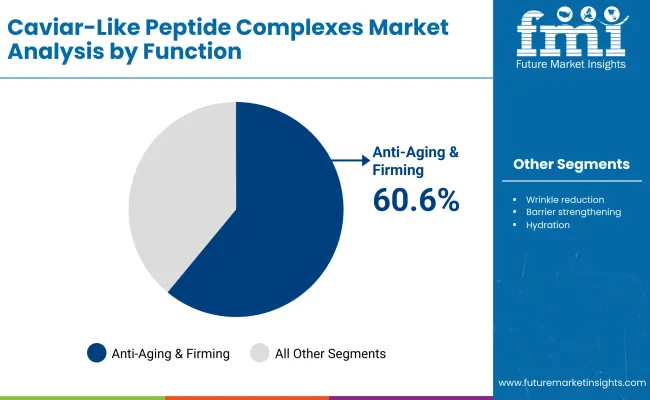
| Function | Value Share% 2025 |
|---|---|
| Anti-aging & firming | 60.6% |
| Others | 39.4% |
The anti-aging & firming segment is projected to contribute 60.6% of the Caviar-Like Peptide Complexes Market revenue in 2025, maintaining its lead as the dominant functional category. This growth is fueled by the increasing use of signal and carrier peptides that target dermal aging pathways, stimulate collagen production, and visibly reduce fine lines. Consumers are prioritizing scientifically validated solutions that offer both preventative and corrective skincare benefits.
The segment’s rise is also reinforced by the integration of anti-aging peptides into high-performance formulations such as encapsulated serums and clinical-grade ampoules. As brands focus on targeted efficacy, anti-aging & firming products are being positioned as multi-benefit solutions that align with dermatology-backed routines and personalized skincare regimens. The function is expected to remain the core driver of value in peptide-based skincare systems.
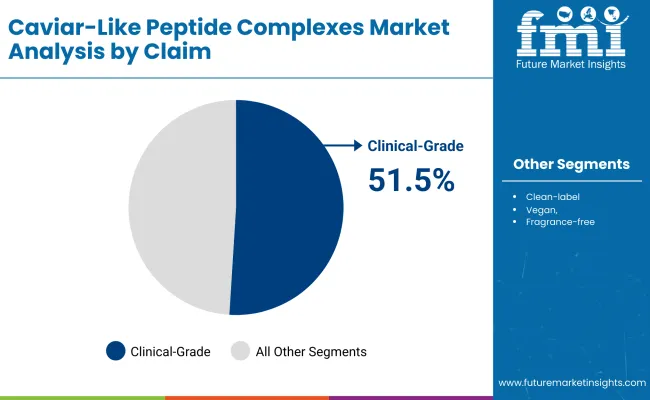
| Claim | Value Share% 2025 |
|---|---|
| Clinical-grade | 51.5% |
| Others | 48.5% |
The clinical-grade segment is forecasted to hold 51.5% of the market share in 2025, led by its widespread use in high-efficacy skincare protocols and dermatologist-endorsed formulations. These products are favored for their proven performance in reducing wrinkles, improving firmness, and repairing skin barriers making them ideal for consumers seeking visible and measurable results.
Their targeted formulation and strong backing from dermatological testing have facilitated widespread adoption across dermatology clinics, pharmacies, and premium retail channels. The segment’s growth is further strengthened by innovation in peptide delivery systems, such as encapsulated “caviar bead” technologies, which improve ingredient stability and skin absorption. As skincare routines become more results-oriented, clinical-grade claims are expected to retain their leadership in driving market value.
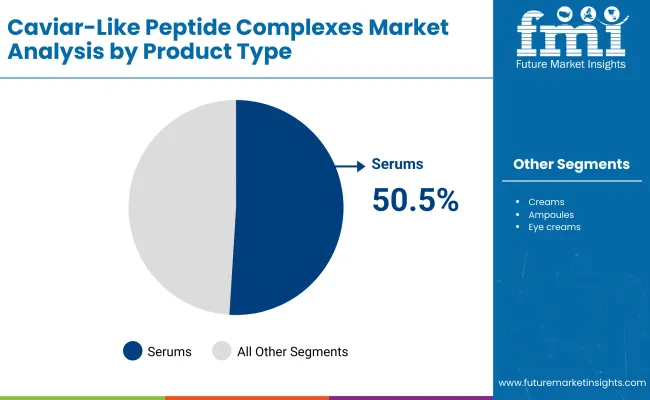
| Product Type | Value Share% 2025 |
|---|---|
| Serums | 50.5% |
| Others | 49.5% |
The serum segment is projected to account for 50.5% of the Caviar-Like Peptide Complexes Market revenue in 2025, establishing it as the leading product type. Serums are preferred for their lightweight texture and ability to deliver concentrated active ingredients, such as peptides, deep into the skin for fast and visible results.
Their compatibility with encapsulated “caviar bead” peptide systems makes them ideal for targeted skincare needs like wrinkle reduction, firming, and hydration. Serums are also favored for use in both day and night routines, allowing for versatile application across age groups and skin types. Given their strong consumer acceptance and premium positioning, serums are expected to maintain their leading role in shaping product innovation in the Caviar-Like Peptide Complexes Market.
Professional Skincare Channel Expansion
The growing presence of dermatology clinics and pharmacies as retail channels is significantly boosting demand for caviar-like peptide complexes. These clinical settings endorse products with proven anti-aging efficacy, positioning them as trusted solutions for wrinkle reduction and skin firming. As consumers increasingly seek science-backed formulations, peptide-rich complexes are becoming a core component of post-procedure regimens and preventive skincare. The blend of clinical validation, convenience, and premium appeal in professional channels is reinforcing category credibility and driving sustained market growth.
Innovation in Encapsulated Delivery Systems
Advanced encapsulation technologies, such as caviar bead systems, are reshaping the performance of peptide-based skincare. These delivery systems stabilize peptides and enhance absorption into deeper skin layers, making formulations more effective and sensorially luxurious. The visual appeal of bead-in-serum formats also appeals to the premium skincare segment. As consumers increasingly demand visible, fast-acting results, brands leveraging encapsulated peptides are gaining a competitive edge driving both new product development and higher price realization across the Caviar-Like Peptide Complexes Market.
High Formulation Costs and Ingredient Sensitivity
Despite their benefits, caviar-like peptide complexes involve high formulation costs due to the sourcing of bioactive peptides, specialized encapsulation, and stability challenges. Peptides are sensitive to degradation from light, heat, and oxidation, requiring advanced preservation systems. These factors limit their inclusion in mass-market products and constrain accessibility in cost-sensitive regions. Furthermore, not all peptides are universally well-tolerated, especially among sensitive skin users creating a barrier to widespread adoption and complicating product formulation for brands targeting broader demographics.
Rise of Multifunctional Peptide Skincare
The market is witnessing a shift toward multifunctional peptide-based skincare, where products offer anti-aging, hydration, barrier repair, and brightening in a single formulation. Consumers especially in Asia and Europe are seeking simplified routines with fewer steps but higher efficacy. Brands are responding by developing concentrated formulas powered by diverse peptide systems, including signal, carrier, and enzyme-inhibiting peptides. This multifunctional trend is not only reducing regimen complexity but also enhancing perceived value, positioning caviar-like peptides as a smart investment in daily skincare.
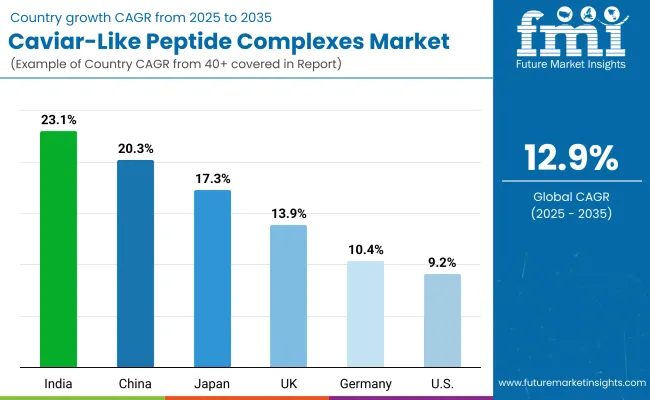
| Countries | Estimated CAGR (2025 to 2035) |
|---|---|
| China | 20.3% |
| USA | 9.2% |
| India | 23.1% |
| UK | 13.9% |
| Germany | 10.4% |
| Japan | 17.3% |
The global Caviar-Like Peptide Complexes Market exhibits diverse growth patterns across regions, shaped by factors such as skincare innovation adoption, consumer trust in clinical efficacy, and the strength of dermatological distribution networks.
Asia-Pacific leads market acceleration, with India (23.1%) and China (20.3%) posting the highest CAGRs. India's rapid growth is driven by expanding access to dermatology-grade skincare, rising disposable incomes, and increased awareness of anti-aging peptides among urban millennials. China, on the other hand, benefits from a well-developed cosmeceutical retail ecosystem, government support for domestic skincare innovation, and consumer preference for clinical-grade and high-tech skincare products, such as encapsulated peptides and “caviar bead” formats. Japan (17.3%) maintains a strong growth trajectory due to its mature beauty market embracing multifunctional skincare formats, a cultural preference for minimal yet high-performance routines, and its leadership in peptide R&D.
In Europe, markets like the UK (13.9%) and Germany (10.4%) are gaining momentum through strong uptake of dermatologist-backed brands and growing trust in peptide efficacy over botanical alternatives. Strict product labeling regulations and increasing demand for vegan and fragrance-free clinical formulations are also influencing purchasing decisions. The USA market (9.2%) reflects more modest growth due to its already established base, but remains pivotal as a global trendsetter. Demand is increasingly shifting toward professional skincare channels, subscription-based regimens, and tech-enabled personalization platforms. American consumers are also driving demand for serum-centric delivery, where caviar-like peptide complexes have proven especially effective.

| Year | USA Caviar-Like Peptide Complexes Market (USD Million) |
|---|---|
| 2025 | 245.54 |
| 2026 | 275.47 |
| 2027 | 309.05 |
| 2028 | 346.72 |
| 2029 | 388.98 |
| 2030 | 436.39 |
| 2031 | 489.59 |
| 2032 | 549.27 |
| 2033 | 616.22 |
| 2034 | 691.33 |
| 2035 | 775.60 |
The Caviar-Like Peptide Complexes Market in the United States is projected to grow at a CAGR of 12.1% from 2025 to 2035, driven by rising demand for dermatologist-recommended, clinical-grade skincare among aging and high-income consumer segments. USA brands are investing heavily in formulation science, combining signal peptides, carrier peptides, and caviar-bead encapsulation technologies to offer targeted anti-aging and firming benefits. The growth is supported by strong performance in dermatology clinics, pharmacies, and premium online retailers, where consumers seek science-backed products with measurable outcomes.
The Caviar-Like Peptide Complexes Market in the United Kingdom is expected to grow at a CAGR of 13.9% between 2025 and 2035, supported by the rising consumer shift toward clinical-grade, efficacy-led skincare. British consumers, known for their preference for minimalist but potent routines, are increasingly embracing serum-based peptide treatments and dermatology-approved firming solutions. The market is also seeing strong activity from cosmeceutical brands collaborating with NHS dermatology departments and university research labs to validate peptide efficacy and skin compatibility.
India is witnessing exceptional growth in the Caviar-Like Peptide Complexes Market, which is forecast to expand at a CAGR of 23.1% through 2035making it the fastest-growing country in this segment. Increased demand from tier-2 and tier-3 cities is driven by improved access to premium skincare, rising influence of dermatology clinics, and growing consumer education around peptide-based anti-aging solutions. Domestic and global brands are launching affordable clinical-grade serums tailored to Indian skin concerns such as pigmentation, early aging, and barrier damage.
The Caviar-Like Peptide Complexes Market in China is expected to grow at a CAGR of 20.3%, the highest among leading economies. This momentum is driven by the rise of clinical-grade cosmeceuticals, intense digital beauty marketing, and growing trust in science-backed formulations. Domestic skincare brands are launching affordable peptide-rich products while aligning with TCM-meets-clinical narratives. Government-backed support for cosmetic R&D and the popularity of “functional beauty” trends are helping peptides become a mainstream active across mass and premium skincare shelves.
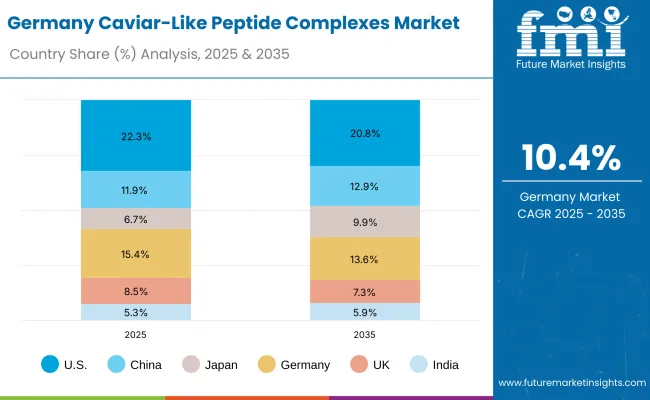
| Countries | 2025 Share (%) |
|---|---|
| USA | 22.3% |
| China | 11.9% |
| Japan | 6.7% |
| Germany | 15.4% |
| UK | 8.5% |
| India | 5.3% |
| Countries | 2035 Share (%) |
|---|---|
| USA | 20.8% |
| China | 12.9% |
| Japan | 9.9% |
| Germany | 13.6% |
| UK | 7.3% |
| India | 5.9% |
The Caviar-Like Peptide Complexes Market in Germany is projected to grow at a CAGR of 10.4%, driven by the country’s established reputation for cosmeceutical innovation and pharmaceutical-grade formulation standards. German skincare consumers are highly discerning, with a strong preference for clinically validated, fragrance-free, and dermatologically approved products. The market is benefiting from widespread retail availability of encapsulated peptide serums, along with expanding applications in dermatology clinics and apothecaries. Regulatory alignment with EU cosmetic safety laws and demand for functional aging-care solutions continue to support market development.
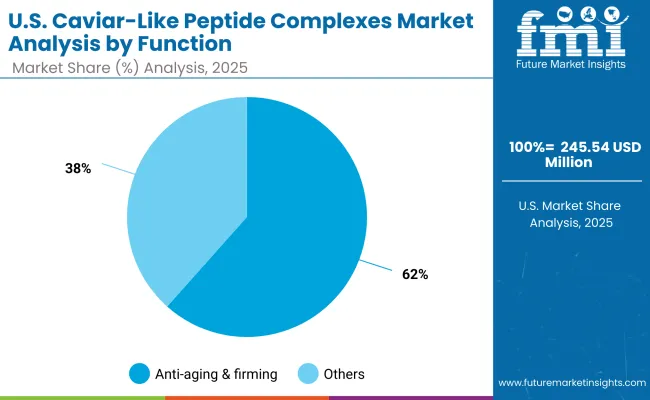
| USA by Function | Value Share% 2025 |
|---|---|
| Anti-aging & firming | 61.6% |
| Others | 38.4% |
The Caviar-Like Peptide Complexes Market in the USA is projected at USD 245.54 million in 2025. Anti-aging & firming contributes 61.6%, while other skincare functions make up 38.4%, highlighting a strong focus on visible, performance-driven skin correction. This dominance reflects consumer demand for clinical-grade peptides, often integrated into dermatologist-approved regimens across both retail and professional skincare channels.
The USA market is also undergoing a shift toward data-enabled skincare personalization, with brands integrating AI skin analysis tools, app-based diagnostics, and prescriptive peptide treatments. As consumers prioritize high-efficacy, trackable outcomes, brands offering tailored formulations and smart skincare routines are gaining traction. The rise of subscription models, clinical partnerships, and hybrid skin-health ecosystems is redefining market dynamics.
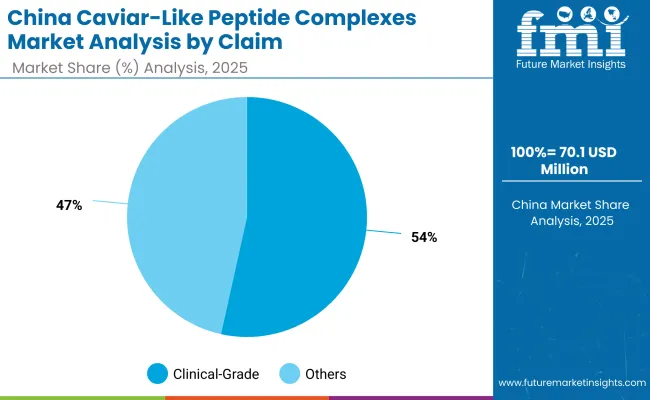
| China by Claim | Value Share% 2025 |
|---|---|
| Clinical-grade | 53.5% |
| Others | 46.5% |
The Caviar-Like Peptide Complexes Market in China is positioned for rapid growth, with clinical-grade skincare leading at 53.5% share in 2025. This dominance is driven by China’s evolving beauty consumer who demands science-backed, functional formulations over traditional cosmetic claims. Local brands are leveraging this shift by launching dermatologist-endorsed, peptide-rich products, particularly in serum and ampoule formats, which are perceived as high-efficacy yet minimalistic.
Government support for domestic cosmeceutical innovation and ingredient-level transparency regulations are further accelerating clinical-grade adoption. Meanwhile, TCM-inspired brands are fusing bioactive peptides with traditional ingredients, creating hybrid offerings that appeal to both scientific and cultural skincare values. With mobile beauty apps and AI-driven skin diagnostic tools on the rise, China is becoming a testbed for personalized peptide skincare, opening significant opportunities for both local and international players.
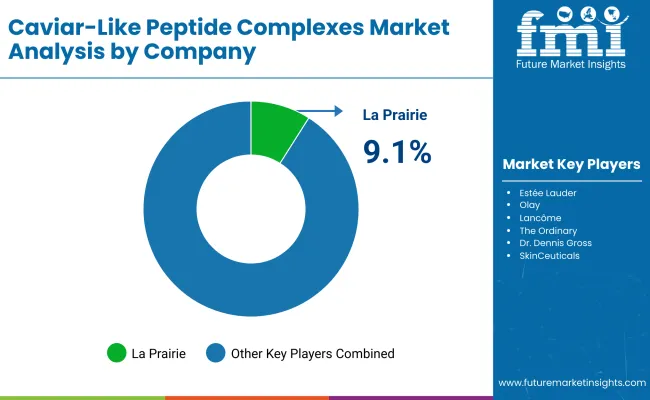
The Caviar-Like Peptide Complexes Market is moderately fragmented, with global luxury skincare giants, cosmeceutical innovators, and clinical niche players competing across multiple skin health applications. Global leaders such as La Prairie, Estée Lauder, and Lancôme dominate market share through their premium positioning, proprietary peptide complexes, and encapsulated delivery technologies tailored for firming, wrinkle reduction, and skin rejuvenation.
Established mid-sized players, including The Ordinary, SkinCeuticals, Dr. Dennis Gross, and Murad, focus on clinical-grade efficacy at accessible price points. Their strategies emphasize transparent ingredient communication, dermatologist-backed claims, and serum-centric formulations powered by signal and carrier peptides. These companies have built strong traction across both DTC e-commerce and professional dermatology networks.
Niche-focused specialists such as Sederma (Matrixyl) and emerging APAC brands are driving innovation in enzyme-inhibiting peptides, fragrance-free variants, and clean-label caviar-like complexes. Their competitive strength lies in biotech formulation capabilities, regional consumer insight, and agile product development pipelines. Competitive differentiation is shifting away from traditional brand prestige toward clinical validation, encapsulation science, and platform-based skincare ecosystems. Brands integrating AI-driven skin diagnostics, personalized regimens, and subscription-based peptide treatments are gaining momentum as the market pivots toward performance-led, high-retention skincare models.
Key Developments in Caviar-Like Peptide Complexes Market
| Item | Value |
|---|---|
| Quantitative Units | USD 1,102.3 Million |
| Function | Anti-aging & firming, Wrinkle reduction, Barrier strengthening, Hydration |
| Peptide System | Signal peptides, Carrier peptides, Enzyme-inhibiting peptides, Encapsulated “caviar bead” systems |
| Product Type | Serums, Creams, Ampoules, Eye creams |
| Channel | Premium beauty retail, E-commerce, Pharmacies, Dermatology clinics |
| Claim | Clinical-grade, Clean-label, Vegan, Fragrance-free |
| Regions Covered | North America, Europe, Asia-Pacific, Latin America, Middle East & Africa |
| Country Covered | United States, Canada, Germany, France, United Kingdom, China, Japan, India, Brazil, South Africa |
| Key Companies Profiled | La Prairie, Estée Lauder, Olay, Lancôme, The Ordinary, Dr. Dennis Gross, SkinCeuticals, Shiseido, Murad, Sederma (Matrixyl) |
| Additional Attributes | Dollar sales by function and product type, adoption trends in clinical skincare and dermatology-led treatments, rising demand for encapsulated peptide delivery systems in serum formats, sector-specific growth in premium retail, e-commerce, and dermatology clinics, revenue segmentation by clinical-grade, vegan, and fragrance-free claims, integration with AI-powered skin diagnostics and personalized skincare apps, regional trends influenced by cosmeceutical regulations and urban consumer awareness, and innovations in signal peptides, carrier peptides, enzyme-inhibiting peptides, and encapsulated “caviar bead” technologies. |
The global Caviar-Like Peptide Complexes Market is estimated to be valued at USD 1,102.3 million in 2025.
The market size for the Caviar-Like Peptide Complexes Market is projected to reach USD 3,725.2 million by 2035.
The Caviar-Like Peptide Complexes Market is expected to grow at a 12.9% CAGR between 2025 and 2035.
The key product types in the Caviar-Like Peptide Complexes Market are serums, creams, ampoules, and eye creams. Among these, serums are expected to dominate, driven by their compatibility with encapsulated peptide systems and high absorption efficacy in anti-aging and firming applications.
In terms of product segmentation, the serums segment is expected to command a 50.5% share of the Caviar-Like Peptide Complexes Market in 2025, making it the leading format. This dominance is attributed to serums' ability to deliver concentrated peptides in lightweight, fast-absorbing formulations that support clinical-grade positioning.






Full Research Suite comprises of:
Market outlook & trends analysis
Interviews & case studies
Strategic recommendations
Vendor profiles & capabilities analysis
5-year forecasts
8 regions and 60+ country-level data splits
Market segment data splits
12 months of continuous data updates
DELIVERED AS:
PDF EXCEL ONLINE
Peptide-Infused Anti-Aging Serums Market Analysis - Size and Share Forecast Outlook 2025 to 2035
Peptide Based Nanomaterials Market Size and Share Forecast Outlook 2025 to 2035
Peptide-Infused Tinted Moisturizers Market Size and Share Forecast Outlook 2025 to 2035
Peptide-Enhanced Firming Creams Market Analysis - Size and Share Forecast Outlook 2025 to 2035
Peptide Drug Conjugates Market Size and Share Forecast Outlook 2025 to 2035
Peptide-based Sweetener Size and Share Forecast Outlook 2025 to 2035
Peptide Supplements Market Analysis - Size, Share, and Forecast Outlook 2025 to 2035
Peptide Receptor Radionuclide Therapy (PRRT) Market Trends and Forecast 2025 to 2035
Peptide Synthesis Market Analysis – Trends, Share & Growth 2025 to 2035
Key Players & Market Share in the Peptide Microarray Sector
Peptide Therapeutics Market Analysis - Growth & Forecast 2024 to 2034
Peptide Antibiotics Market
Peptide Microarrays Market
Tuna Peptides Market – Growth, Demand & Functional Benefits
Plant Peptides Market Size and Share Forecast Outlook 2025 to 2035
Tetra-Peptide Anti-Wrinkle Solutions Market Analysis - Size, Share, and Forecast Outlook 2025 to 2035
Custom Peptide Synthesis Services Market Size and Share Forecast Outlook 2025 to 2035
Animal Peptides Market Size and Share Forecast Outlook 2025 to 2035
Marine Peptide Market Size and Share Forecast Outlook 2025 to 2035
Lupine Peptides Market Size and Share Forecast Outlook 2025 to 2035

Thank you!
You will receive an email from our Business Development Manager. Please be sure to check your SPAM/JUNK folder too.
Chat With
MaRIA